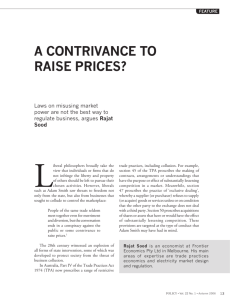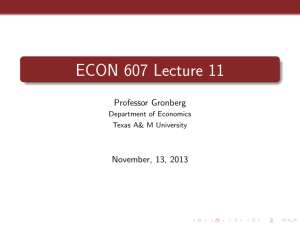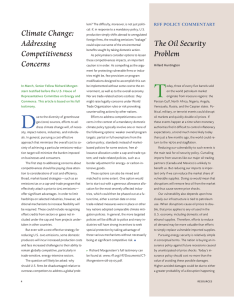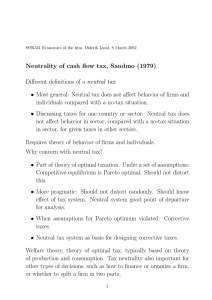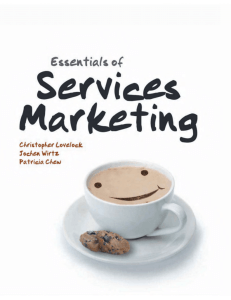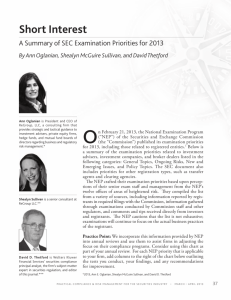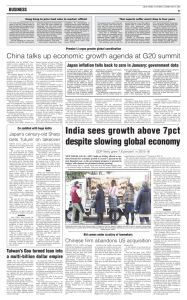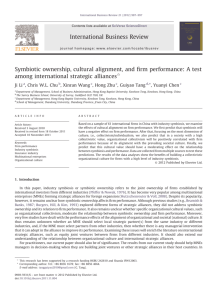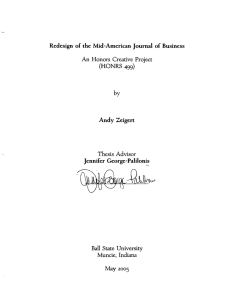HEALTH ECONOMICS
advertisement
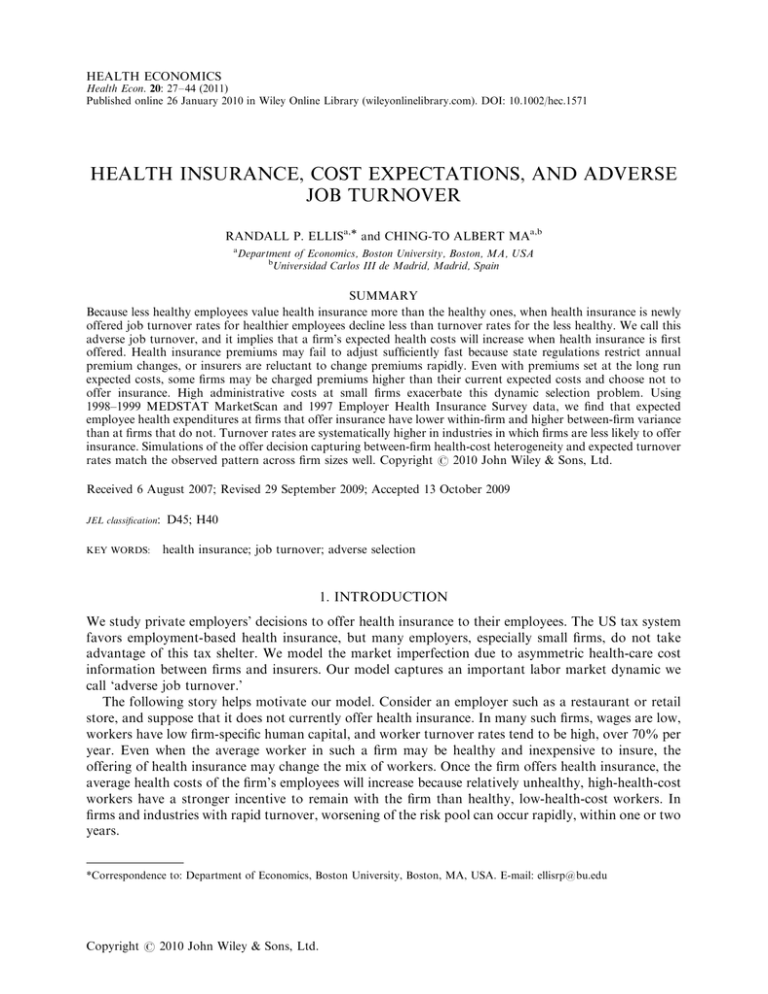
HEALTH ECONOMICS Health Econ. 20: 27–44 (2011) Published online 26 January 2010 in Wiley Online Library (wileyonlinelibrary.com). DOI: 10.1002/hec.1571 HEALTH INSURANCE, COST EXPECTATIONS, AND ADVERSE JOB TURNOVER RANDALL P. ELLISa, and CHING-TO ALBERT MAa,b a Department of Economics, Boston University, Boston, MA, USA b Universidad Carlos III de Madrid, Madrid, Spain SUMMARY Because less healthy employees value health insurance more than the healthy ones, when health insurance is newly offered job turnover rates for healthier employees decline less than turnover rates for the less healthy. We call this adverse job turnover, and it implies that a firm’s expected health costs will increase when health insurance is first offered. Health insurance premiums may fail to adjust sufficiently fast because state regulations restrict annual premium changes, or insurers are reluctant to change premiums rapidly. Even with premiums set at the long run expected costs, some firms may be charged premiums higher than their current expected costs and choose not to offer insurance. High administrative costs at small firms exacerbate this dynamic selection problem. Using 1998–1999 MEDSTAT MarketScan and 1997 Employer Health Insurance Survey data, we find that expected employee health expenditures at firms that offer insurance have lower within-firm and higher between-firm variance than at firms that do not. Turnover rates are systematically higher in industries in which firms are less likely to offer insurance. Simulations of the offer decision capturing between-firm health-cost heterogeneity and expected turnover rates match the observed pattern across firm sizes well. Copyright r 2010 John Wiley & Sons, Ltd. Received 6 August 2007; Revised 29 September 2009; Accepted 13 October 2009 JEL classification: KEY WORDS: D45; H40 health insurance; job turnover; adverse selection 1. INTRODUCTION We study private employers’ decisions to offer health insurance to their employees. The US tax system favors employment-based health insurance, but many employers, especially small firms, do not take advantage of this tax shelter. We model the market imperfection due to asymmetric health-care cost information between firms and insurers. Our model captures an important labor market dynamic we call ‘adverse job turnover.’ The following story helps motivate our model. Consider an employer such as a restaurant or retail store, and suppose that it does not currently offer health insurance. In many such firms, wages are low, workers have low firm-specific human capital, and worker turnover rates tend to be high, over 70% per year. Even when the average worker in such a firm may be healthy and inexpensive to insure, the offering of health insurance may change the mix of workers. Once the firm offers health insurance, the average health costs of the firm’s employees will increase because relatively unhealthy, high-health-cost workers have a stronger incentive to remain with the firm than healthy, low-health-cost workers. In firms and industries with rapid turnover, worsening of the risk pool can occur rapidly, within one or two years. *Correspondence to: Department of Economics, Boston University, Boston, MA, USA. E-mail: ellisrp@bu.edu Copyright r 2010 John Wiley & Sons, Ltd. 28 R. P. ELLIS AND C.-T. ALBERT MA Insurers anticipate this adverse job turnover dynamic. Nevertheless, insurers are expected to renew policies and may be reluctant or prohibited from increasing premiums rapidly. As a result, offered premiums for covering a previously uninsured firm are well above the initial expected costs for the firm’s worker’s current age and gender distributions. Such large premium loadings deter small firms from offering health insurance to their workers. A dynamic adverse selection problem emerges. Employers with favorable health risks are reluctant to offer insurance because the premium is too high to be attractive to the existing mix of employees. Furthermore, offering insurance may attract less healthy workers, worsening the expected health costs in the firm. Our new insight is on the interaction between relative labor turnover dynamics and lack of insurers’ premium flexibility. A related possibility is that high labor turnover may be preferred by some employers, especially small firms that employ homogenous workers with low job-specific human capital. Workers tolerant of high turnover tend to be younger and healthier. By not offering health insurance, despite the tax advantage, these firms deter older and less healthy workers. High administrative costs of offering health insurance in small firms further exacerbate this dynamic selection problem. Our model provides an explanation for the well-documented pattern that small firms are much more likely to forgo health insurance than medium and large firms. Our model identifies new explanations for why large and small firms make different insurance offer decisions; they are based on turnover rates and within-firm and between-firm heterogeneities. Large firms tend to have greater within-firm heterogeneity than small ones, and so they are more likely to have some employees who strongly desire health insurance and less likely to attract only workers who do not find health insurance attractive. Our main insight is that small firms face a more severe selection problem because their expected health-care cost distributions have higher between-firm variances, and small firms have private information about their own expected costs. Our stylized model generates several empirical hypotheses about the insurance offer decision. Firms in industries where labor turnover rates are high do not tend to offer insurance. Premium rigidities will be most pronounced in such industries. Firms not offering insurance will tend to have lower health-cost variability and lower average expected health spending than firms offering insurance; for example, they have higher proportions of younger workers or are in industries where workers tend to be healthy. These firms need not have high within-firm variability of employee health costs as proposed by Bundorf (2002). Industries or markets with greater between-firm age and average employee income heterogeneity (rather than within-firms) are more vulnerable to dynamic selection. For example, if firms already have older workers, they face less vulnerability to increased work force aging as a result of insurance. Our empirical analysis uses two different data sources: the Robert Wood Johnson Foundation’s 1997 Employer Health Insurance Survey (EHIS) and MEDSTAT MarketScan commercially insured health claims and eligibility information for 1998–1999. We first use the EHIS data to examine turnover patterns and their relationship to firm and employee characteristics. The EHIS data reveal that small firms are very heterogeneous; the heterogeneity concerns workers’ turnover rates, besides workers’ age distribution and other health-related demographic variables. The diversity in job turnover rates across firms has received little attention in the literature on the uninsured; in our dynamic model, its presence exacerbates the adverse job turnover problem. Firms with higher turnover rates are at greater risk of rapid changes in health costs and, hence, less likely to offer insurance. Firms with higher proportions of young workers also have higher job turnover rates and lower insurance rates than firms with higher proportions of older workers. We then turn to the MEDSTAT MarketScan data in order to understand the implications of health spending levels and variation across firms by industry and size. Building on the work of Ellis and McGuire (2007), we develop a model of the distribution of predictable health-care spending at the individual level and pair these distributions with the EHIS data to simulate the distribution of expected covered medical spending costs across firms. By repeatedly drawing random samples of employees for each firm to mimic the age, gender, and industry of the firm’s actual employees, we generate Copyright r 2010 John Wiley & Sons, Ltd. Health Econ. 20: 27–44 (2011) DOI: 10.1002/hec HEALTH INSURANCE, COST EXPECTATIONS, AND ADVERSE JOB TURNOVER 29 distributions of expected health spending that would be realized by each firm. A simple decision model that includes mean spending, risk aversion, and administrative costs is used to calculate the proportion of random draws in which a firm of each size and industry would choose to buy insurance, and these are compared to empirical rates by size and industry. Many policy makers and researchers believe that voluntary cost pooling of employees across small firms will make insurance affordable to these firms. This is possible because, on average, expected costs of employees at small firms are only slightly higher than large firms. We show that risk pooling across firms may not work as well as this conventional wisdom would suggest, because of large between-firm heterogeneity in employee characteristics at small firms. Even if a fair average premium is charged, risk pooling will be inadequate to induce many small-to-medium-sized firms with favorable health-cost distributions or low preferences for insurance to purchase insurance. This adverse selection problem is further exacerbated by the adverse job turnover problem we model theoretically. Other researchers have studied the issues examined here. Excellent articles by Blumberg and Nichols (2004), Chernew and Hirth (2004), and Gruber and Madrian (2004) have carefully documented many reasons why so many Americans are uninsured. There is no single and simple explanation about why many firms refuse to offer insurance and why employees sometimes refuse to accept these offers. The problem is complex. In this article, we focus on labor market turnover and expectations to explain firms’ insurance offer decisions. Various papers in the literature have recently discussed labor turnover. Fang and Gavazza (2007) model wage determination and health investment under exogenous and endogenous labor turnover. Owing to separation, workers invest less in health capital, and so health expenditure decreases in labor turnover rate. Their result is complementary to ours; both show that higher turnover and lower insurance are associated. Nevertheless, heterogeneous worker health costs and their correlation to turnover rates are not considered in their model. These two elements are central to adverse job turnover in our model. Cebul et al. (2008) consider a model where health-plan premiums are diverse and employers have to engage in costly search. Employers may change health plans when the search cost is not prohibitively high. Nevertheless, in their model, the quality of health plans is assumed to be identical, and so changing health plans merely reflects a transfer. Their model does not consider firms’ insurance offer decision, which is the focus of our study. We make many simplifying assumptions. We do not explicitly model unions, higher labor productivity from healthy workers, the tax subsidy for employment-based health insurance, or heterogeneity in worker risk aversion. Nor do we model possible exclusions for pre-existing conditions, which is another reason for high-turnover firms not offering insurance (Hall, 2000). All of these considerations no doubt matter. In health-care cost simulations, we make the assumption that all employees are single, whereas in practice many have families and will purchase family rather than individual coverage. The EHIS data do not include information on the proportion of employees who hold family rather than individual contracts unless the firm offers insurance.1 We ignore issues of single versus family coverage and multiple insurance offers within a family. 2. A MODEL OF INSURANCE, TURNOVER, AND EXPECTATIONS Assume there is a large population of potential workers with heterogeneous health-care costs. Let f(c) be the density function distribution of workers’ costs in this general work force. The support of f is a which is denoted by C. positive closed interval [c; c], 1 In support of our assumption that single versus family coverage variation does not explain the insurance offer decision, analysis of MEPS data by Kate Bundorf suggests that employees of small and large firms have nearly identical proportions of single versus married employees, and single rather than married coverage is chosen in nearly the same proportions across firm size, and so marital status does not seem to be a major determinant of employer decision to offer insurance. Copyright r 2010 John Wiley & Sons, Ltd. Health Econ. 20: 27–44 (2011) DOI: 10.1002/hec 30 R. P. ELLIS AND C.-T. ALBERT MA We study a dynamic model, one with a potentially infinitely number of discrete periods. Let t 5 1, 2, 3yy denote time periods. At the beginning of a given period t, a firm has hired workers from the marketplace. We normalize the mass of hired workers to one, and this is to remain constant over time. The density of health costs of workers at the firm in period t is denoted by ft(c). This density R is not necessarily f. At the beginning of period t, the firm’s expected health cost is gt ¼ C cft ðcÞ dc. Employed workers may search for jobs either actively or passively; hence, in a given period, each employed worker may leave the firm with some probability. The likelihood that any worker may leave the firm depends negatively on the worker’s health cost. Let l be a decreasing function defined on C and take values strictly between 0 and 1. The function l is a worker’s departure rate, and this describes the firm’s worker turnover in each period. The function l being decreasing is the source of adverse job turnover. It asserts that workers who have higher (expected) health costs tend to stay with a firm. Those who remain are more costly to the firm, on average, than those who leave. The assumption accords well with the fact that young workers (who tend to be healthy) have higher turnover rates than older workers (Neal, 1999; Topel and Ward, 1992), and less healthy workers are more reluctant to change jobs than healthy workers when there is a chance that a new job will not offer health insurance (Stroupe et al., 2001). Once they have found employment, less healthy workers tend to stay with a given firm relatively longer than more healthy workers (Gilleskie and Lutz, 2002). At the end of period t, some workers will have left the firm. The density of health-care costs of workers who have left is l(c)ft(c), and so the density at the beginning of the period, ft, is now reduced by the departure rate l. At the end of period t, the mass of workers who have left is Z Lt ¼ lðcÞft ðcÞ dc: C The firm must replace these workers. We focus on a small firm, and so assume that when the firm replaces workers, it hires from the general work force. A total mass of Lt will be hired, and a replacement worker’s health costs follow the density f. After the replacement by new workers, at the beginning of the period t11, the density of health costs of workers in the firm is ft11 ðcÞ ¼½1 lðcÞft ðcÞ1Lt fðcÞ Z ¼½1 lðcÞft ðcÞ1 lðxÞft ðxÞ dx fðcÞ: ð1Þ C In a steady state, ft ¼ ft11 f, and it is easy to see from (1) that we have Z fðcÞ ¼ ½1 lðcÞfðcÞ1 lðxÞfðxÞ dx fðcÞ ð2Þ C which simplifies to fðcÞlðcÞ ¼ fðcÞ Because we require that R C Z lðxÞfðxÞ dx: ð3Þ C fðxÞ dx ¼ 1, we can simply set fðcÞ ¼ fðcÞ K lðcÞ and choose the value of K to satisfy Z Copyright r 2010 John Wiley & Sons, Ltd. fðcÞ 1 dc ¼ : K C lðcÞ Health Econ. 20: 27–44 (2011) DOI: 10.1002/hec HEALTH INSURANCE, COST EXPECTATIONS, AND ADVERSE JOB TURNOVER 31 The steady-state cost density is proportional to the ratio of the general work force cost density to the departure rate. In a steady state, from (3), we have R Z clðcÞfðcÞ dc RC ¼ cfðcÞ dc ¼ g; C C lðxÞfðxÞ dx which says that the expected cost of the departing workers is equal to the general work force expected cost, g. The steady-state expected cost is Z fðcÞ Z Z dc c fðcÞ lðcÞ 4g ð4Þ K dc ¼ ZC cfðcÞ dc ¼ c fðcÞ C C lðcÞ dc C lðcÞ where the inequality follows because l is a decreasing function and of the choice of K. In a steady state, the firm’s expected health cost must be higher than the general work force average because less costly workers tend to leave the firms more often than more costly workers. To study the stability of the expected cost over time, from (1) we have the following dynamics about costs: Z gt11 ¼ gt ðc gÞlðcÞft ðcÞ dc ð5Þ C Now consider the term inside the integral. In period t, the expected cost of departing workers is R clðcÞft ðcÞ dc RC : C lðxÞft ðxÞ dx If in period t, the expected cost of departing workers is higher than the general work force average, according to (5), the expected cost in the following period, gt11 , will be reduced from period t. Symmetrically, if the expected cost of departing workers is smaller than the general work force average, expected cost will increase. Therefore, the system is stable, with the firm’s expected cost converging to the steady state, at which point, the expected cost of departing workers is the work force average. The worker departure or turnover rate l is assumed to be constant. In practice, it may well depend on a firm’s insurance offer. A health insurance benefit will be attractive to workers. The value of l(c) may become lower once a firm offers insurance. We can introduce this effect by the following. Suppose that when the firm provides health insurance as part of worker compensation, the departure rate l(c) changes to l(c)HIl(c)h(c) where 0oh(c)r1. We naturally let h(c) be a decreasing function, so that health insurance reduces the departure rates of high-cost workers more than low-cost workers. Naturally, workers who are less healthy value health insurance more and their departure rates are correspondingly reduced more than workers who are healthier. Now under the health insurance regime, a firm’s steady-state cost distribution and expected cost can be obtained by replacing the term l(c) in the above expressions by l(c)h(c). Hence, from (4), we obtain the steady-state expected health cost under insurance: Z fðcÞ dc c lðcÞhðcÞ ZC fðcÞ dc C lðcÞhðcÞ which has increased from the value of the expected cost in (4) because h is decreasing. The offering of insurance will tend to raise the steady-state expected health cost of the firm. Copyright r 2010 John Wiley & Sons, Ltd. Health Econ. 20: 27–44 (2011) DOI: 10.1002/hec 32 R. P. ELLIS AND C.-T. ALBERT MA Next, we can modify our model to account for different firm sizes. For notational convenience and ease of exposition, we have used a continuum model. A firm hires a unit mass of consumers. The size of the firm then becomes a normalization and hence has no bearing on the dynamics and steady-state properties. In practice, firms hire a finite number of workers, and the law of large number becomes a poor approximation when the firm is small. Even when a small firm draws from the same work force as any other firm, the variance of workers’ health-care cost may be larger. The most convenient way to modify our model to account for the larger variance is the following. We continue to use f(c) to denote the health-cost distribution of the general work force facing a large firm, but modify it to f(c)s(c) for a small firm, where f(c)s(c) is a mean-preserving spread of f(c). Thus, small and large firms face the same expected health cost, but the small firm, when drawing a random worker from the work force to replace a departed worker, experiences a larger variance in health cost than a large firm. A mean preserving spread on the health-cost distribution will imply that more firms will have costs significantly below the mean. Firms obviously choose to insure risk-averse workers when the premium is fair. They may choose to do so even if the premium is slightly higher than the expected cost. Nevertheless, if a firm’s expected health cost is significantly lower than the premium, it may choose not to offer insurance to workers. As we have just observed, small firms have higher variances in health costs. Hence, relative to large firms, more small firms will have expected costs that are significantly below the offered premium, and they choose not to offer insurance to workers. We have described a simple employment process and time-path of a firm facing workers with different health-care costs and (correlated) departure rates. How is this related to the firm’s insurance provision decision? More important, what sort of premiums will a firm face? If fair insurance policies are offered to the firm in each period, the firm must find it advantageous to provide health insurance to workers because of risk aversion. Favorable tax treatment strengthens this advantage. An insurer, however, may not know a firm’s employment situation or lifecycle, and offering insurance at a fair premium may be infeasible. Moreover, other market failures due to asymmetric information may be present (Rothschild and Stiglitz, 1976). Even if insurance markets are highly competitive, and problems due to asymmetric information are small, restrictions on rates of premium levels or changes over time may create new problems. Hall (2000) describes some of the regulations that cause problems in this setting: ‘Rating bands and community ratings y restrict how much an insurer can vary its rates in a given period, but they set no limits on how much rates can rise from one period to the next. However most states also limit how much an insurer can raise a particular purchaser’s rates, relative to the insurer’s average increases. These limits are intended to prevent a practice known as ‘churning,’ which results from insurers giving steep discounts initially, but then increasing rates steeply at renewal, forcing subscribers to look for new coverage, even if claims did not exceed first year estimates. Insurers have justified these increases by observing that claims costs tend to increase rapidly after the first year or two of coverage.’ (p. 381). Regulations such as these prevent insurers from selling actuarially fair policies to firms in each period. Holding premiums constant for multiple years is not a problem for an insured firm in steady state. Once turnover and cost distributions have stabilized, it can be a problem for firms trying to transition from an uninsured to insured condition. The employer’s existing set of employees may not desire insurance given its high initial premium. Our theoretical model generates four predictions summarized below. 1. Firms choosing not to offer insurance will be common in industries and firm sizes with high turnover rates, since they will be the most vulnerable to rapidly changing employee health costs and preferences. Copyright r 2010 John Wiley & Sons, Ltd. Health Econ. 20: 27–44 (2011) DOI: 10.1002/hec HEALTH INSURANCE, COST EXPECTATIONS, AND ADVERSE JOB TURNOVER 33 2. Higher between-firm health-cost heterogeneity and taste heterogeneity will make it more likely that firms do not insure. 3. Firms in industries with high expected health costs are more likely to insure than firms with low expected health costs, since they are unlikely to experience adverse job turnover once they offer insurance. 4. High administrative costs of insurance, which are exacerbated by both small firm sizes and high job turnovers, create another strong reason for firms not to offer insurance. We test these predictions against our data. 3. DATA We use data from a variety of sources. Our primary file on firm characteristics is the Robert Wood Johnson Foundation 1997 Employer Health Insurance Survey (EHIS). The survey collects a rich set of information about the firms: regardless of whether insurance is offered, establishment size, 10 broad industry groups, and most important from our perspective, the proportion of female workers and the percent of workers in each of four broad age categories. Starting from the full survey on 41 432 employers, we exclude results from government establishments, firms with no permanent full time employees, firms with missing values (mostly for income or industry type), and firms with over 5000 employees (which may have self-administration and other options available to them). Our final estimation sample includes 20 585 firms. Our simulation model focuses on the 18 712 firms with less than 100 full-time, permanent employees. In addition to the EHIS data, we use a sample of 890 000 employees from the MEDSTAT MarketScanTM commercially insured population. From the matching insurance claims for these employees, we obtain 1998 and 1999 annual total spending from covered charges on inpatient, outpatient, and drugs. We process the MarketScan claims data using DxCG software, which assigns to each person a vector of binary variables called ‘Hierarchical Condition Categories’ (HCCs) for predicting future health-care spending based on health status (Ash et al., 2000). The MarketScan data also contain age, gender, and aggregated industry codes for each enrollee. These Marketscan data are used to estimate models of covered spending for each individual in 1999 using lagged spending variable splines and HCCs. Predicted values from these models are created for each individual in the sample. We use these insurance eligibility files with actual and predicted spending data to develop distributions of expected health-care spending at the firm level by randomly assigning patients in the MEDSTAT data to firms in the EHIS data. We repeatedly drew patients with replacement from the MEDSTAT file to generate 250 pseudo-firms that match the EHIS data in terms of their age, gender, and SIC code. We use these 250 synthetic firm-level draws to calculate the mean expected health-care spending at the firm level, and the within-firm standard deviation of mean health spending for each of the firms in the Marketscan data with 100 or fewer employees. Variation in these means across firms allows us to look at between-firm variability in health-care spending for each industry, firm size, and insurance status. Our method expands on the work of Bundorf (2002), in that we develop estimates not only for expected health-care spending and the within-firm but also for the between-firm variability of firm- level expected health spending, which our theory tells us is important. 4. RESULTS Summary statistics on the variables are listed in Table I. Using earlier versions of EHIS, Bundorf (2002) and others have shown that characteristics of firms offering health insurance differ substantially from those that do not. Turnover rates, defined as the sum of employees arriving and employees departing the firm divided by the reported current number of employees, are 9% points higher for firms that do not Copyright r 2010 John Wiley & Sons, Ltd. Health Econ. 20: 27–44 (2011) DOI: 10.1002/hec 34 R. P. ELLIS AND C.-T. ALBERT MA Table I. Sample means, RWJ 1997 EHIS sample of private employers All firms (N 5 20 585) Mean Insurance not offered Turnover rate Employee characteristics Fulltime proportion Temporary proportion Union proportion Employee gender, age and income Females Employees age o25 Employees age 25–34 Employees age 35–44 Employees age 451 Income o$10k Income $10–14k Income $14–20k Income $20–30k Income $30K1 Industry codes Agriculture, fisheries, forestry Construction Manufacturing and mining Transport, commun, utilities Wholesale trade Retail trade Financial services Professional services Firm size measures Size 5 number of full time employees More 5 1 if more employees nationwide 1–9 employees at establishment 10–24 employees at establishment 25–49 employees at establishment 50–99 employees at establishment 100–249 employees at establishment 2501 employees at establishment Std. dev. Firms offering insurance (N 5 13 587) Firms not offering insurance (N 5 6998) Mean Std. dev. Mean Std. dev. t-Test of difference in means 0.34 0.48 0.47 0.80 0.00 0.45 0.72 1.00 0.54 0.93 7.12 0.88 0.07 0.04 0.22 0.18 0.16 0.90 0.06 0.05 0.19 0.16 0.18 0.82 0.10 0.01 0.27 0.22 0.10 22.44 11.83 18.28 0.43 0.28 0.30 0.24 0.18 0.06 0.18 0.24 0.26 0.27 0.32 0.27 0.25 0.24 0.24 0.18 0.29 0.28 0.28 0.31 0.42 0.29 0.30 0.24 0.17 0.03 0.14 0.23 0.28 0.32 0.30 0.25 0.22 0.22 0.21 0.13 0.23 0.25 0.26 0.31 0.43 0.28 0.29 0.24 0.19 0.11 0.27 0.25 0.21 0.17 0.35 0.30 0.29 0.28 0.28 0.25 0.35 0.32 0.30 0.29 0.80 1.91 2.63 1.97 6.73 23.47 28.44 4.34 16.90 35.43 0.00 0.08 0.14 0.05 0.05 0.19 0.17 0.24 0.05 0.27 0.35 0.22 0.22 0.39 0.38 0.43 0.002 0.07 0.17 0.06 0.06 0.14 0.18 0.26 0.045 0.26 0.38 0.23 0.24 0.35 0.38 0.44 0.003 0.10 0.08 0.04 0.03 0.28 0.16 0.21 0.052 0.30 0.27 0.19 0.17 0.45 0.37 0.41 1.00 6.20 19.95 6.85 9.79 21.53 2.99 7.46 60.11 0.33 0.51 0.21 0.11 0.07 0.05 0.04 253.15 0.47 0.50 0.41 0.32 0.26 0.23 0.20 86.10 0.43 0.37 0.24 0.15 0.10 0.08 0.06 307.35 0.50 0.48 0.43 0.36 0.30 0.27 0.25 9.64 0.15 0.78 0.15 0.05 0.02 0.00 0.00 35.35 0.35 0.41 0.36 0.21 0.12 0.07 0.05 28.64 46.96 64.37 16.14 25.52 29.10 30.60 27.93 offer insurance than those that do. The proportions of workers who are full time, temporary, and unionized all affect the offer decision. Employee age and income distributions are also important predictors. These individual level characteristics have been shown to matter in earlier studies (Bundorf, 2002; Blumberg and Nichols, 2004). Although selected employee characteristics matter, the t-tests in Table I reaffirm that two strongest predictors of a firm’s insurance offer decision are its size and industry. Therefore, we aim for a better understanding of these two dimensions. About 70% of firms that have only one or two permanent employees do not offer health insurance. Figure 1 illustrates that not offering insurance is especially common among very small firms, with proportion of firms not offering insurance stabilizing at 30–50 employees. This size pattern is not explained by the industry mix of small firms: Figures 2 and 3 reveal that firm size remains a strong predictor of whether firms offer insurance even after controlling for firms’ industries. Firms in construction and retail trade seldom offer insurance, yet within these two industries there is still a strong tendency for large firms to offer health insurance. Similar patterns hold for other two-digit industries. Copyright r 2010 John Wiley & Sons, Ltd. Health Econ. 20: 27–44 (2011) DOI: 10.1002/hec HEALTH INSURANCE, COST EXPECTATIONS, AND ADVERSE JOB TURNOVER 35 100% Percent not offering health insurance 90% 80% 70% 60% 50% 40% 30% 20% 10% 0% 20 0 60 40 100 80 Number of full time permanent employees Figure 1. Plot of firm size versus percent of firms not offering health insurance. Plot uses RWJ 1997 EHIS data, for firm sizes less than 100. N 5 18 588. Firms with sizes between 25 and 49 inclusive were collapsed into five categories of size to ensure that at least 100 firms were in each collapsed category, while firms with 50 or more enrollees were grouped into firm size intervals of 10. Data points are sample proportions for given firm sizes 100% Percent of firms not offering insurance 90% 80% 70% 60% 50% 40% 30% 20% 10% 0% 0 10 20 30 40 50 60 70 80 90 100 Number of full time permanent employees Wholesale Professional service Finance Other service Retail Figure 2. Plot of percent of firms not offering insurance versus firm size, by five industries. 1997 EHIS data, firms fewer than 100 employees Multivariate models are often used to identify individual and firm characteristics that best predict turnover rates and employers’ health insurance offer decision, the two key components of our theoretical model. However, a key implication of our theory model is that the age, health, income, and Copyright r 2010 John Wiley & Sons, Ltd. Health Econ. 20: 27–44 (2011) DOI: 10.1002/hec 36 R. P. ELLIS AND C.-T. ALBERT MA 100% Percent of firms not offering insurance 90% 80% 70% 60% 50% 40% 30% 20% 10% 0% 0 10 20 30 40 50 60 70 80 90 100 Number of full time permanent employees Mining/manufacture Agriculture Transportation Constructation Figure 3. Plot of percent of firms not offering insurance versus firm size, by four industries. 1997 EHIS data, firms o100 employees other demographic characteristics of firms are endogenous to the decision of whether to offer health insurance: in small firms, employees may sort themselves into firms that do and do not offer health insurance. Given this endogeneity, instrumental variables approaches are necessary in order to identify structural relationships. Unfortunately, the EHIS data do not contain suitable instruments to identify these key relationships. The firm’s industry and size seem like the best exogenous variables, and therefore we rely on graphical rather than regression techniques to examine the equilibrium conditions observed in the health insurance and labor market. Graphical techniques reveal that there is a strong correlation between turnover rates and the firm’s decision not to offer health insurance, and this pattern holds both in the aggregate (Figure 4) and when firm size is controlled for (Figure 5). In each figure, the average turnover rate is measured on the horizontal axis and the proportion of firms not offering health insurance is measured on the vertical axis. Figure 5 shows that even among firms of a given size interval, there is still a significant and positive relationship between turnover rates and firms’ decision not to offer health insurance. We have hypothesized that expected health costs rather than ex-post actual health costs of employees should drive employers’ insurance offer decision. Since employees join firms and employers choose plans before their health spending decisions are made, it is the distribution of expected rather than actual health costs that matters for risk selection and insurance choice (Ellis and McGuire, 2007). What information do employees and their employers use to form expectations about future costs? As an approximation, we use the MarketScan data to develop several alternative models that predict future health spending. Contrasting their implications is a contribution of our article. We estimate four alternative linear regression models.2 The first model uses only demographic information; the second uses disaggregated prior year spending with splines; the third uses prior year diagnoses organized according to the DxCG HCC system; and the fourth model is a ‘kitchen sink’ 2 Ellis and McGuire (2007) and Jiang et al. (2009) estimate nonlinear models of health-care spending and show that their distributions of expected spending generate similar results to the linear models. For this paper, we examine only the linear models. Copyright r 2010 John Wiley & Sons, Ltd. Health Econ. 20: 27–44 (2011) DOI: 10.1002/hec HEALTH INSURANCE, COST EXPECTATIONS, AND ADVERSE JOB TURNOVER 37 0.6 Other services Retail trade Proportion not offering insurance 0.5 Agri/forest/fishing Construction 0.4 Finance/insurance/real estate Professional services 0.3 Transport/Commu/Util Mining/manufacturing Wholesale trade 0.2 0.1 0 0 0.1 0.2 0.3 0.4 0.5 0.6 0.7 Turnover rate (=new employees+departing employees)/total employees 0.8 Figure 4. Turnover rate versus proportion of firms not offering insurance, by industry. RWJ 1997 EHIS data, N 5 18 588 firms with o100 full-time employees. Each point is one industry 0.8 Proportion not offering insurance 0.7 0.6 0.5 0.4 0.3 0.2 0.1 0 0 0.1 0.2 0.3 0.4 0.5 0.6 0.7 0.8 Employee turnover rate 2-9 100+ Linear (50-99) 10-24 Linear (2-9) Linear (100+) 25-49 Linear (10-24) 50-99 Linear (25-49) Figure 5. Employee turnover rates versus proportion not offering insurance, by industry and firm size. RWJ 1997 EHIS data, N 5 18 588 firms with o100 full-time employees. Each point is mean for one industry and firm size. Linear trend lines are shown for each firm size across industries model that uses all of the above. Estimated coefficients from the first and second regressions are shown in Appendix Table AI; regression coefficients from the third and fourth models, which involve hundreds of coefficients, are available from the authors upon request. Expected spending from each of the predictive models allows us to generate individual level predictions. By taking repeated draws of Copyright r 2010 John Wiley & Sons, Ltd. Health Econ. 20: 27–44 (2011) DOI: 10.1002/hec 38 R. P. ELLIS AND C.-T. ALBERT MA individuals, matched individuals with each firm’s industry, and employee age, we generate means and the distributions of expected covered medical spending for sets of hypothetical workers at each firm. Figure 6 shows that the distribution of expected health costs is not nearly as skewed as the actual cost distribution. Also informative is that the distribution of expected costs is relatively insensitive to the information used for the predictions. The distribution of expected spending the following year is nearly identical whether we use prior year diagnoses, lagged spending information, or both sets of variables to form predictions. Because the information used does not matter much, for the simulations described below we use the most easily generated set of information, which is lagged spending based on splines of lagged inpatient, outpatient, and drug spending. Also included in the model are dummy variables for industry, plan type, individual age, gender, and employee status (e.g. salaried or wage) as shown in Appendix Table AI. MEDSTAT data cover primarily large firms with over 1000 employees and contain very few small firms. It is infeasible to match the MEDSTAT and EHIS data at the firm level in a satisfactory way. Instead, we generate random samples of hypothetical employees that match as closely as possible the industry, age categories, and gender ratio of the employees in the EHIS sample. We draw 250 random sets of matching employees from the MEDSTAT data for each EHIS firm. Table II summarizes the result of these simulations at the firm level. The distribution of expected health-care spending for small firms differs markedly between small firms (1–9 and 10–24 employees) and large firms (100 or more). Mean expected health costs of small versus large firms differ only modestly, because of their age, gender, and industry. Small firms having health costs that are about 3% above the average ($1666 versus $1619), while firms with 25–49 employees average about 5 percentage points below the grand mean for all firms. Also listed in Table II is that the between-firm standard deviation of expected health-care costs is substantially higher for small firms than large firms ($1143 versus $255). This cost heterogeneity means that many more small firms than large ones will decide that insurance is not worthwhile. The bottom row of Table II adds on the estimated administrative costs of insurance for firms with different sizes from Chu and Trapnell (2002) to come up with actuarially fair premiums if all firms in a given size cohort were to purchase insurance. The numbers in this bottom row would be actuarially fair 100% 90% 80% Percent of sample 70% 60% 50% 40% 30% 20% 10% 0% 0 0.5 1 1.5 2 Cost relative to population average Ex post actual costs Lagged spending spline Age-Sex only Kitchen sink 2.5 3 DCG/HCC model Figure 6. Distributions of expected medical spending at individual level using different information sets for prediction. See text for interpretation Copyright r 2010 John Wiley & Sons, Ltd. Health Econ. 20: 27–44 (2011) DOI: 10.1002/hec HEALTH INSURANCE, COST EXPECTATIONS, AND ADVERSE JOB TURNOVER 39 Table II. Percentile distributions of predicted spending from 250 simulations of each firm, by firm size categories Number of full-time permanent employees Percentiles 100% 99% 95% 90% 75% 50% 25% 10% 5% 1% 0% N Mean predicted cost Std. dev. Administrative cost multiplier Imputed premium 1–9 10–24 25–49 50–99 100–249 2501 All firms 31 442 5310 3205 2615 1954 1480 1090 788 622 267 0 10 403 1666 1143 1.33 2154 10 042 3663 2529 2180 1792 1478 1220 1033 922 767 483 4292 1579 595 1.25 2024 5440 2900 2281 2022 1726 1470 1285 1140 1067 915 743 2348 1546 399 1.25 2024 3199 2623 2145 1940 1711 1504 1338 1204 1140 1009 875 1469 1552 315 1.20 1943 3056 2470 2107 1925 1719 1541 1366 1255 1194 1083 952 1100 1572 285 1.16 1878 2690 2535 2055 1964 1766 1618 1454 1320 1247 1162 1081 893 1629 255 1.05 1700 31 442 4392 2769 2319 1828 1495 1215 946 771 418 0 20 505 1619 878 1.27 2062 Notes: This table was generated by combining RWJ 1997 EHIS and MEDSTAT 1998–1999 data. A total of 250 random samples of employees from the MEDSTAT data matching the age-gender-industry intervals were drawn for each firm appearing in the EHIS data. Average predicted spending per employee is shown where predictions are generated using demographic and lagged spending splines as in Model 2 of A-1. Imputed premiums were calculated assuming fully community rating. Imputed premiums are the grand mean average cost ($1619) increased by average administrative cost percentages based on Chu and Trapnell (2002). premium in the absence of tax subsidies and if all firms chose insurance and insurance loading factors are added on. By comparing this imputed ‘fair’ premium with the percentiles of expected cost, we can see how many firms of a given size would optimally choose to purchase insurance if they are risk neutral and they use the lagged spending information when creating expectations of future health spending. For example, the median expected health cost of small firms (1–9 employees) is only $1480, but the imputed premium is $2154; firms would demand health insurance at a premium nearly 50 % above expected costs only if their employees are very risk adverse or tax subsidies are large. Although Table II provides insight for a risk neutral firm with no tax subsidies and no worker turnover, actual firms and their employees benefit from tax subsidies, display risk averse, and experience costly turnover. It is beyond this article to estimate the magnitude and impact of each of these elements. Therefore, we used a simulation model with simplified decision rules on to examine insurance offer decisions. For each of the 250 hypothetical sets of employees, we calculate whether the firm would prefer to offer insurance or not. In what follows, we examine how one particular rule generates a pattern of insurance offer decisions most similar to the aggregate pattern observed in Figures 1–3. The firm offer decision rule we use for our simulations is this: Offer health insurance if (average covered health cost per employees) (risk aversion adjustment) 4imputed premium1 (administrative costs per new employee) (expected job turnover). The first term is generated by our data, the expected health cost for each of the 250 random draws for each firm in the EHIS data. The second term captures the well-known result that insurance premiums need not be actuarially fair to attract enrollees: owing to tax subsidies and risk aversion, even premiums that are two or three times the actuarial expectations can still attract firms. For our simulations, we use a multiplier of 3.0 times expected costs as a reasonable upper bound on employee willingness to pay for health insurance. The third term, the imputed premium, is also generated by our data. We use the grand mean average health cost for our entire sample, and then apply the insurance loading factors (Chu and Trapnell, 2002), which vary with firm size, already discussed above. The final term is the administrative Copyright r 2010 John Wiley & Sons, Ltd. Health Econ. 20: 27–44 (2011) DOI: 10.1002/hec 40 R. P. ELLIS AND C.-T. ALBERT MA costs of offering health insurance with high turnover. We assume that it costs $100 to manage the arrival and departure of one employee. The probability that the firm would offer insurance is the proportion of random firm draws with sufficiently low expected health-care costs that the above decision rule is satisfied and the firm would choose to offer health insurance. Figure 7 illustrates the actual and simulated proportion of firms that choose to offer insurance in our sample by firm size. Our simple model is able to match the pattern found in Figure 1 strikingly well. The cost of accommodating turnover particularly affects small firms because of their greater between-firm heterogeneity, while the risk aversion and tax subsidy multiplier shifts the offer distribution curve up and down for all firm sizes. The combination of moderate costs of turnover ($100/worker) with a relatively strong risk aversion and tax subsidy multiplier (3.0) generates the closest approximation of the empirical distribution. The driving force behind a firm’s insurance offer decision is the structure of heterogeneity. Firms that do not offer insurance have low within-firm heterogeneity in costs and preferences but high between-firm heterogeneity in health costs. Each of these two dimensions of heterogeneity helps firms sort themselves between offering and not offering insurance. Although we have formally modeled only cost heterogeneity, within- and between-firm heterogeneities in workers age and income – both affecting risk aversion – should also affect the firm’s insurance offer decision. Table III presents sample means and within-firm and between-firm standard deviations in three key variables: employee age, income, and expected health spending. The sample is our EHIS estimation sample of firms with less than 100 workers, with merged multiple health spending draws appended. The table confirms the prediction that firms that offer health insurance have higher within-firm variability of age and income, but lower between-firm variability than firms that do not. For health expenditures, firms that offer health insurance have not only lower withinfirm but also lower between-firm heterogeneity than firms that do not. Table III examines heterogeneity in a large EHIS sample of firms, whereas Figure 1 reveals that not offering insurance is particularly concentrated among the smallest of firms and is industry-specific. Do the patterns of heterogeneity hold up after controlling for firm size and industry? Figure 8 illustrates the pattern of between-firm heterogeneity in health costs in four industries that are at the extremes of 0.8 Proportion not offering insurance 0.7 0.6 0.5 0.4 0.3 0.2 0.1 0 0 10 20 30 40 50 60 70 80 90 100 Number of full time permanent employees Actual Uninsured Rate Simulated Uninsured Rate Figure 7. Actual versus simulated proportions of firms choosing not to offer health insurance, by firm size. Simulation shown is for fixed cost of $100 per new employee hired and tax subsidy plus risk aversion adjustment of three times the expected cost. Hence, the specific rule for this simulation is do not offer insurance when (expected cost3)o$100turnover1premium Copyright r 2010 John Wiley & Sons, Ltd. Health Econ. 20: 27–44 (2011) DOI: 10.1002/hec 41 HEALTH INSURANCE, COST EXPECTATIONS, AND ADVERSE JOB TURNOVER Table III. Comparisons of various firm heterogeneity measures using EHIS data 1997 using sample of firms with less than 100 full time employees All firms (N 5 18 588) Employee age Mean Within-firm standard deviation Between-firm standard deviation Income (in thousands) Mean Within-firm standard deviation Between-firm standard deviation Predicted health-care costs Mean Within-firm standard deviation Between-firm standard deviation Firms offering Insurance (N 5 11 640) Firms not offering insurance (N 5 6948) 38.18 7.17 6.89 38.02 7.75 6.29 38.45 6.21 7.78 22.29 4.61 7.24 24.04 5.27 6.56 19.37 3.49 7.37 1629 720 279 1620 618 260 1640 890 307 Figure 8. Between firm heterogeneity in expected health costs versus firm size, by industry turnover and offer decisions as revealed in Figure 5. In calculating these estimates, we used the sample mean by firm size and industry group to calculate the variance in expected costs. In all four industries, the between-firm simulated variability in expected costs declines sharply with firm size. Moreover, among the smallest firms, between-firm heterogeneity is highest in the ‘retail’ and ‘other service’ industries, which have the highest rates of not offering insurance. For the similar firm sizes, betweenfirm heterogeneity in health costs is lowest in the ‘mining and manufacturing’ and ‘wholesale’ industries (with the lowest rates of not offering insurance). No other explanatory variable that we have considered matches the distinct patterns by firm size and industry of the no offer decision. Copyright r 2010 John Wiley & Sons, Ltd. Health Econ. 20: 27–44 (2011) DOI: 10.1002/hec 42 R. P. ELLIS AND C.-T. ALBERT MA 5. CONCLUDING REMARKS We have developed a theoretical model to explain why some employers rationally decide not to offer insurance. Our model captures the following elements. Small firms differ greatly in their expected health costs, and so when offered premiums that imperfectly reflect expected costs, they are able to exploit private information about expected health costs when deciding whether to offer insurance to their employees. Firms make this decision based on their existing employees, and firms with low expected health-cost employees are unwilling to pay the average premium to offer insurance. The new insight of our article is that high and endogenous job turnover rates (which we call adverse job turnover) exacerbate the static asymmetric information problem. Even if an employer has relatively young and healthy employees, premiums may need to increase rapidly due to high turnover rates and differential turnover rates for healthy and high-cost employees. Rather than raising premiums rapidly after the first year, insurers may only offer high initial premiums. Firms that choose to purchase insurance are those that highly value low turnover rates, that already have high health cost workers, or that have sufficiently heterogeneous workers some of whom strongly desire health insurance. Our empirical results lend support to this theory. Firms not offering insurance have higher turnover rates than those that do. Even after controlling for firm size and industry, there is a positive relationship between turnover and the decision to forgo insurance. Large and small firms do not differ significantly in their average turnover rates, yet the insurance offer decision varies significantly with actual turnover. Between-firm heterogeneity of expected health costs, which is closely related to firm size, is a new element in thinking about the insurance offer decision. We have chosen to model and emphasize health-cost heterogeneity, yet income and risk aversion heterogeneity together with high turnover can also lead to similar results, which are supported by our empirical findings. The key assumption is that firms and insurers consider the preferences of their existing employees when making the health insurance offer decision, not the preferences of workers who may arrive once insurance is newly offered. For these dimensions of preferences, no justification about premiums being slow to change is needed, only the simple argument that firms make choices that are attractive to their existing employees. Our model and results identify adverse job turnover as a new and important partial rationale for why certain firms and industries have high rates of not offering insurance. Our framework provides a new mechanism – constraints on rates of premium increase, heterogeneous firm-level expected costs, and endogenous employee turnover – for thinking about why firms often choose not to offer insurance. ACKNOWLEDGEMENTS Support for this study was provided by the Robert Wood Johnson Foundation’s Economic Research Initiative on the Uninsured, funded through the University of Michigan. We are grateful to MEDSTAT for facilitating the use of their data and DxCG Inc. for donating programming time to create the analytical files. M. Kate Bundorf generously calculated various statistics using the MEPS data for which we are very grateful. We thank Pooja Gupta Mookim for her programming assistance and Tom Buchmueller, Michael Chernew, Denise Doiron, Jennifer Foster, Jim Rebitzer, Elizabeth Savage, Mark Votruba, Pedro Bita Barros, two anonymous referees, and seminar participants at Boston University, Case Western Reserve University, University of Chicago, iHEA Barcelona, and the University of Michigan ERIU conference for their helpful comments. Any errors or omissions are our own. APPENDIX A Linear regression model of annualized total covered medical spending excluding drugs of employees is given in Table AI. Copyright r 2010 John Wiley & Sons, Ltd. Health Econ. 20: 27–44 (2011) DOI: 10.1002/hec 43 HEALTH INSURANCE, COST EXPECTATIONS, AND ADVERSE JOB TURNOVER Table AI. Linear regression model of annualized total covered medical spending excluding drugs of employees (MEDSTAT MarketScan Commercially insured adults, aged 18–65) Demographic only 2 R Root MSE N Dependent variable Mean 0.011 7332.497 891 857 1817 Coefficient Intercept 387 Industry Manufact., durable goods 124 Manufact., nondurable goods 33 Services 127 Transportation, communication 83 Missing — Plane type Basic/major medical 348 Comprehensive 488 HMO 403 POS 158 POS with capitation 266 PPO — Single 47 Age and age splines Age 45 Max(0, age–30) 34 Max(0, age–40) 57 Max(0, age–50) 39 Max(0, age–60) 203 Discrete age– sex categories Female, aged 18–24 725 Female, aged 25–34 932 Female, aged 35–44 661 Female, aged 45–54 513 Female, aged 55–64 422 Female, aged 60–64 368 Male, aged 18–24 — Male, aged 25–34 150 Male, aged 35–44 22 Male, aged 45–54 120 Male, aged 55–59 247 Male, aged 60–64 683 Employee classes Salary nonunion Salary union Salary other Hourly nonunion Hourly union Hourly other Nonunion Union Unknown Splines using lagged health spending information Dummy 5 1 if any OP$ OP $ in 1998 Max(0,OP$–100) Max(0,OP$–500) Max(0,OP$–1000) Max(0,OP$–5000) Max(0,OP$–10 000) Max(0,OP$–50 000) Copyright r 2010 John Wiley & Sons, Ltd. Demographic with Spline on lagged costs 0.09135 7027.762 891 857 1817 t-value Coefficient 1.63 80 0.35 4.42 0.99 4.81 2.91 — 21 281 295 438 — 0.64 6.26 7.39 10.33 — 3.11 23.49 12.69 4.85 9.19 — 2.84 679 270 425 222 50 — 10 6.1 10.79 12.57 6.44 1.61 — 0.63 4.5 2.41 4.86 2.75 5.62 17 12 26 36 205 1.73 0.85 2.31 2.65 5.95 8.9 10.75 6.56 4.61 3.3 2.33 — 1.72 0.22 1.08 1.94 4.31 506 606 325 242 214 305 — 81 26 200 273 645 6.46 7.27 3.36 2.27 1.75 2.01 — 0.96 0.27 1.87 2.23 4.25 696 873 978 386 453 792 243 177 — 16.83 21.06 20.96 4.99 5.93 19.86 9 1.56 — 131 1.263 0.042 0.112 0.693 0.140 0.505 0.314 t-value 2.67 2.22 0.07 0.77 9.19 5.72 25.78 24.3 Health Econ. 20: 27–44 (2011) DOI: 10.1002/hec 44 R. P. ELLIS AND C.-T. ALBERT MA Table AI. Continued Demographic only Demographic with Spline on lagged costs 218 1.013 1.221 0.468 0.044 0.139 146 1.132 1.074 0.470 1.772 Dummy 5 1 if any IP$ IP$ in 1998 Max(0,IP$–1000) Max(0,IP$–5000) Max(0,IP$–10 000) Max(0,IP$–50 000) Dummy 5 1 if any drug$ Drug$ in 1998 Max(0,drug$–1000) Max(0,drug$–5000) Max(0,drug$–10 000) 0.22 0.99 1.18 8.25 1.68 21.04 3.79 2.08 1.63 1.21 5.27 Notes: Regressions used MEDSTAT Marketscan Commercially insured data using only full time active employees, aged 18–64. Dependent variable is annualized 1999 covered inpatient plus outpatient health care costs Spending by people eligible for only part of 1999 were annualized by dividing by the fraction of the year eligible in that year OP$ stands for covered outpatient spending in 1998, IP$ stands for covered inpatient spending in 1998; drug$ stands for covered drug spending in 1998. REFERENCES Ash AS, Ellis RP, Pope GC, Ayanian JZ, Bates DW, Burstin H, Iezzoni LI, McKay E, Yu W. 2000. Using diagnoses to describe populations and predict costs. Health Care Financing Review 21(3): 7–28. Blumberg LJ, Nichols LM. 2004. Why are so many Americans uninsured? In Health Policy and the Uninsured, McLaughlin CG (ed.). The Urban Institute Press: Washington, DC. Bundorf K. 2002. Employee demand for health insurance and employer health plan choice. Journal of Health Economics 21: 65–88. Cebul RD, Rebitzer JB, Taylor LJ, Votruba ME. 2008. Unhealthy insurance markets: search frictions and the cost and quality of health insurance. NBER Working Paper No. 14455. Chernew ME, Hirth RA. 2004. Challenges in modeling health insurance coverage: gaps in the literature. In Health Policy and the Uninsured, McLaughlin CE (ed.), Chapter 6. Urban Institute Press: Washington, DC. Chu RC, Trapnell GR. 2002. Study of the Administrative Costs and Actuarial Values of Small Health Plans. Actuarial Research Corporation: Annandale, VA. Ellis RP, McGuire TG. 2007. Predictability and predictiveness in health care spending. Journal of Health Economics 26: 25–48. Fang H, Gavazza A. 2007. Dynamic inefficiencies in employment-based health insurance system: theory and evidence. NBER Working Paper No. 13371. Gilleskie DB, Lutz BF. 2002. The impact of employer-provided health insurance on dynamic employment transitions. Journal of Human Resources 37(1): 129–162. Gruber J, Madrian B. 2004. Health insurance, labor supply, and job mobility: a critical review of the literature. In Health Policy and the Uninsured, McLaughlin C (ed.). Urban Institute Press: Washington, DC; 97–178. Hall M. 2000. The structure and enforcement of health insurance rating reforms. Inquiry 37(4): 376–388. Jiang S, Ellis RP, Kuo TZ. 2009. Does service-level spending show evidence of selection across health plan types? Boston University Working Paper. Neal D. 1999. The complexity of job mobility among young men. Journal of Labor Economics 17(2): 237–261. Rothschild M, Stiglitz J. 1976. Equilibrium in competitive markets: an essay on the economics of imperfect information. Quarterly Journal of Economics 90: 629–649. Stroupe KT, Kinney ED, Kniesner TJJ. 2001. Chronic illness and health insurance-related job lock. Journal of Policy Analysis and Management 20(3): 525–544. Topel RH, Ward MP. 1992. Job mobility and the careers of young men. Quarterly Journal of Economics 107(2): 439–479. Copyright r 2010 John Wiley & Sons, Ltd. Health Econ. 20: 27–44 (2011) DOI: 10.1002/hec

